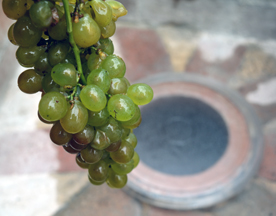 Kathy and I acquired some Rkatsiteli grapes yesterday from our friends at Bluemont Vineyards in Bluemont, Virginia. Arriving home, we began to process the grapes and prepare the qvevri. Qvevri winemaking is an ancient winemaking method and the only winemaking process on the UNESCO list of Intangible Cultural Heritage.
Kathy and I acquired some Rkatsiteli grapes yesterday from our friends at Bluemont Vineyards in Bluemont, Virginia. Arriving home, we began to process the grapes and prepare the qvevri. Qvevri winemaking is an ancient winemaking method and the only winemaking process on the UNESCO list of Intangible Cultural Heritage.
Cleaning the Qvevri
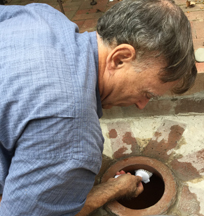 I had learned to clean a qvevri while at Twins Wine Celler in Napareuli in the Kakheti wine region of the country Georgia. The basic process is to pour clean water into the qvevri, and using a brush, scrub the sides. Remove the water and observe the color. Repeat the process until the water is clear once removed. The first time I added water to our qvevri and scrubbed the interior wall of the qvevri, the water was cloudy and opaque. By the fourth bucket of clean water the water had just a touch of cloudiness and was translucent. After the fifth cleaning the water was clear. This paralleled the process that was done to the qvevri we made wine in at Twins Wine Celler.
I had learned to clean a qvevri while at Twins Wine Celler in Napareuli in the Kakheti wine region of the country Georgia. The basic process is to pour clean water into the qvevri, and using a brush, scrub the sides. Remove the water and observe the color. Repeat the process until the water is clear once removed. The first time I added water to our qvevri and scrubbed the interior wall of the qvevri, the water was cloudy and opaque. By the fourth bucket of clean water the water had just a touch of cloudiness and was translucent. After the fifth cleaning the water was clear. This paralleled the process that was done to the qvevri we made wine in at Twins Wine Celler.
To sanitize the qvevri, I sprayed potassium metabisulfite on the interior and soaked up the extra liquid that collected at the qvevri’s base. I did not add another coating of beeswax to the interior of the qvevri. Asking Georgian winemakers how often they coat the interior of the qvevri with beeswax produced a plethora of answers. The answers ranged from reciting yearly to once every several hundred years. I prefer the later response. I noticed while cleaning, that water beaded up on the sides of the qvevri like water beads on a recently waxed car. The beeswax I applied before burying the qvevri last year is doing its job and does not need to be reapplied
Since our qvevri is small, just 23 liters, we were not working with a lot of grapes. We destemmed by hand and gently crushed the grapes before adding to the qvevri. This did take us hours and caused us to wonder about how much faster it would be with a destemmer/crusher. On the other hand, we would only use the machine once a year. Just like last year we sorted the grapes as we pulled them off their jacks. Unlike last year I collected some of the stems to put into the qvevri with the grapes.
While in Georgia, we were told that “Rkatsiteli” means red stem. Some of the stems had begun to turn red and those were the ones I added to the qvevri. In total, the stems only accounted for a small percentage of the must. Kathy and I used up all the grapes and finally had the qvevri filled to within two inches of the surface. We did add yeast, Lalvin D21. In Georgia, the winemakers use the natural yeast on the grapes. They have been making wine there for 8,000 years and the yeasts have figured things out. I did not want to risk using natural yeast so I went with a commercial yeast. After pitching the yeast, I placed a lid on the qvevri that has an airlock in the center. It is fall after all and if I let the qvevri open things would fall into it.
We are now awaiting for the fermentation and daily punchdowns.
Cheers,
Terry
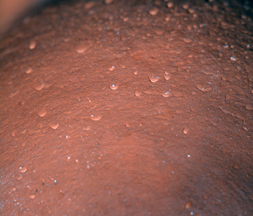
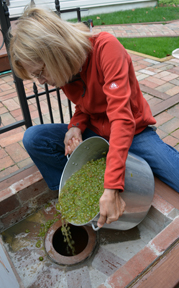
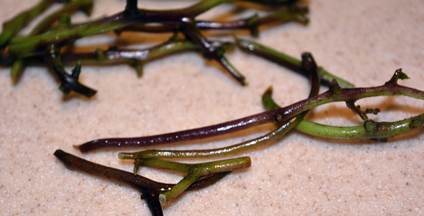



Leave a Reply